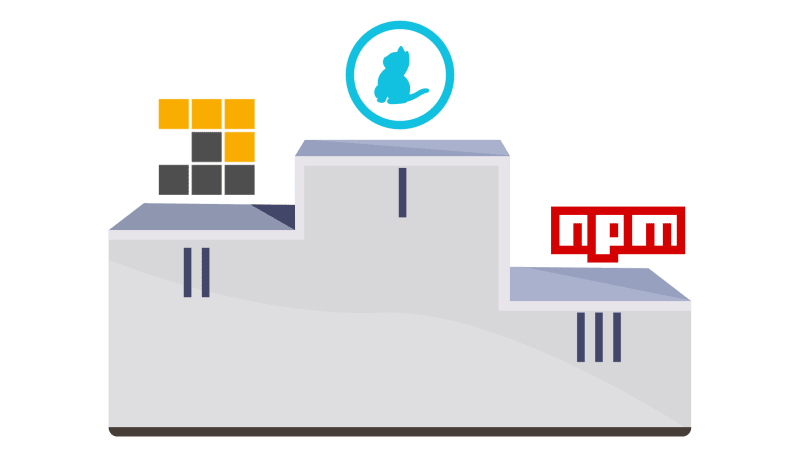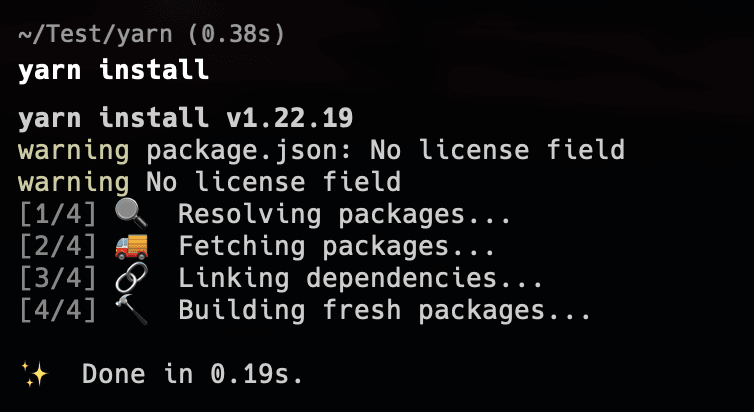Package managers are essential tools for developers that help manage dependencies and streamline the development process. There are several popular package managers available for JavaScript such as npm, Yarn and pnpm. Each of these package managers has its own strengths and weaknesses. It’s important to choose the right package manager based on your project requirements and development needs. I’m looking forward to hearing more about your thoughts on this topic!
1. Speed
I decided to put the installation speed of npm, Yarn, and pnpm to the test. I installed Express, Passport, and dotenv using each package manager and waited impatiently for the installations to finish. I was so impressed by how fast they were that I started to suspect they might have secretly installed themselves while I wasn't looking! But in all seriousness, the results were quite interesting. Keep reading to find out which package manager reigns supreme when it comes to installation speed.
Pnpm
 With its handy lockfile feature, Yarn speeds up installation time
significantly. Sure, npm has been making improvements to its
installation speed lately, but it still can't keep up with the
lightning-fast Yarn. And while pnpm is also faster than npm, it's not
quite as speedy as Yarn. Now, I know what you're thinking - it's just a
small difference in speed, right? But trust me, when you're dealing with
a massive number of dependencies, Yarn's speed will blow your mind!
With its handy lockfile feature, Yarn speeds up installation time
significantly. Sure, npm has been making improvements to its
installation speed lately, but it still can't keep up with the
lightning-fast Yarn. And while pnpm is also faster than npm, it's not
quite as speedy as Yarn. Now, I know what you're thinking - it's just a
small difference in speed, right? But trust me, when you're dealing with
a massive number of dependencies, Yarn's speed will blow your mind!
2. Dependency Resolution
Alright, time for a quick lesson in dependency resolution. Yarn, our
speedy friend from before, uses a deterministic algorithm that ensures
the same set of dependencies are installed on all machines. It's like a
reliable GPS that never leads you astray. On the other hand, npm's flat
dependency structure can sometimes lead to conflicts. It's like a bad
GPS that takes you through the wrong route and leaves you stranded. And
then there's pnpm, our adventurous buddy that likes to live life on the
edge. It installs dependencies by sharing packages between projects,
which can be faster, but can also cause conflicts. It's like a GPS that
takes you on a scenic route, but occasionally leaves you lost in the
wilderness. I would want to give you a good-old-long example here, but
then that will make this blog lengthy && boring.
But Hey, I have a much simpler explanation. Let's take an example package, "PackageX" (let's call it the POWER PUFF PACKAGE). If you have version 3.0.1 of this package installed and your package.json file specifies a range of 3.x.x, then if you reinstall it using npm, it will keep the same version (no upgrade to 3.4.0, which is the latest version). However, if you use Yarn, it will always install the latest matching version, even if you delete the lockfile. This makes Yarn more consistent in its behaviour, ensuring that you get the latest version of the package every time.
3. Offline Mod (OG)
Yarn and pnpm are two package managers that come with a feature that many developers find handy: offline mode. With Yarn or pnpm, you can install packages even if you don't have an internet connection, as long as you have already downloaded the necessary files. This feature can be especially useful if you are working on a project while traveling or in an area with spotty internet connection. However, if you are using npm, you won't have the luxury of an offline mode. That means you'll need a stable internet connection in order to install packages, which can be a bit of a bummer for those who are often on the go.
4. Security
Yarn's security features are nothing to be knitted about! With its use of checksums to ensure package integrity and a built-in command to audit packages for vulnerabilities, Yarn is a real yarn-spinner when it comes to security. Meanwhile, npm and pnpm's security features are similar but not as tightly knit as Yarn's.
Yarn's checksum feature ensures that the installed package matches
the package distributed on the registry. This prevents malicious actors
from tampering with the package during transit. To verify a package's
checksum, you can run the following command in Yarn:
yarn check --integrity
In addition to checksums, Yarn also has a command for auditing packages for security vulnerabilities. This command checks for known security vulnerabilities in all installed packages and their dependencies. It also suggests steps for resolving any vulnerabilities found.
npm also has a similar npm audit command, but it's not as advanced as Yarn's audit feature. pnpm, on the other hand, relies on npm's security features and doesn't have any additional security measures like checksums.
5. Custom Registries
Listen, if you're anything like me, you don't want to be stuck with just the default registries. Thankfully, all three package managers offer some level of support for custom registries. But let's be real: Yarn has the VIP treatment when it comes to private registries. And with its selective version resolution feature, you can cherry-pick the best dependencies from your favorite registry while still keeping things cozy with the default one. Sorry npm and pnpm, but Yarn's got the hookup.
Conclusion
Check out the Why upgrade to Yarn Berry?
 Now,
I know what you're thinking. 'Oh great, here comes the biased opinion.'
But hey, it is what it is. After analyzing all the features and
functionality of Yarn, npm, and pnpm, I gotta say, Yarn takes the cake,
baby! It's faster than a cheetah on caffeine, has security features that
could make a CIA agent jealous, and can handle custom registries like a
boss. Don't get me wrong, npm and pnpm are cool and all, but they're
just not on the same level as Yarn. So, if you want to be the coolest
kid on the block (or in the dev world), use Yarn for all your JavaScript
projects. Trust me, your code will thank you.
Now,
I know what you're thinking. 'Oh great, here comes the biased opinion.'
But hey, it is what it is. After analyzing all the features and
functionality of Yarn, npm, and pnpm, I gotta say, Yarn takes the cake,
baby! It's faster than a cheetah on caffeine, has security features that
could make a CIA agent jealous, and can handle custom registries like a
boss. Don't get me wrong, npm and pnpm are cool and all, but they're
just not on the same level as Yarn. So, if you want to be the coolest
kid on the block (or in the dev world), use Yarn for all your JavaScript
projects. Trust me, your code will thank you.














No comments:
Post a Comment